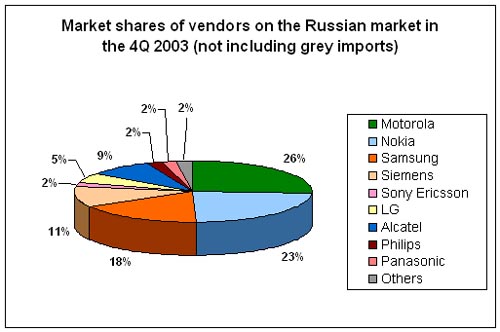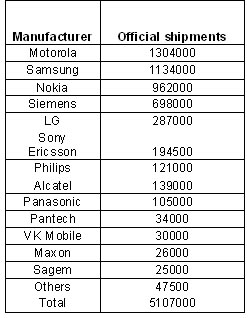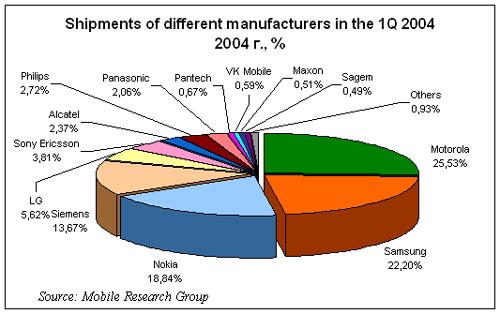|
|
Russian market of mobile terminals in the 1Q 2004
Press release, May 7-th 2004
Statistics: Official shipments of mobile terminals
suggests 5 107 thousand units in the 1Q 2004, while
in the 4Q 2003 they were only 4 053 thousand units. The market growth
was 21% what was caused by liquidation of handsets
shortage, which was in the 2Q 2003. Grey market suggests 5%,
it is a very low index for Russian market, it repeats the results
of the previous quarter. The position of the first 5 manufacturers
was completely different compared to the end of 2003. The value
of shipments (based on FOB prices) was 586 million 655 thousand
Euro.
Short description of the market situation. For
better understanding of the market situation let us return back
to the data of the 4Q 2003. Market shares of the companies in the
4Q 2003 were as displayed below (here and further only sell-in data
of companies are used):

The small volume of grey imports did not have considerable influence
on the market in general and positions of the manufactures in particular.
The main trends of the end of the year were the following: decrease
of Siemens’ sales, overstocking of retail chains by Nokia’s
products. There were about 320 000 terminals from Nokia in the warehouses
on the 1-th of January 2004. About 80% of this amount were phones
which cost more than 150 USD. Such high stocks did not allow the
company to increase its shipments in the 1Q 2004, there were no
sales growth. The stocks were sold mainly during January, in February
retailers made minimum orders because they were waiting for decreasing
of purchasing prices. The first quarter was unsuccessful for Nokia.
The company could reduce stocks but could not remake their structure.
Sales of the 1Q showed that low-end phones from Nokia are the most
demanded ones. Phones of the middle and high price segments are
slowly sold; retail networks purchase only small quantities of these
models.
Vice versa, Samsung’s sales in the middle and high price
segments were increased in the 1Q 2004. Samsung E700 - the top model
of the company had very high sales. Other models, which have already
became popular, were shipped in sufficient quantities. Samsung C100
is a typical example of such product. Nevertheless, Samsung also
had the problem of a shortage of handsets. It could not satisfy
ever-growing demand completely. The situation was the same for all
manufacturers except Nokia.
Absence of thought-out strategy for Nokia, which positioned itself
as the manufacturer of the premium class, affected its sales. Today
phones from Nokia are overpriced by 20%, only after decreasing of
wholesales prices the company will become competitive and active
sales of products begin. MRG experts doubt that Nokia will take
measures, hence, sales of the company will remain the same as in
the 1Q 2004. Passivity of the company allowed Samsung to increase
its sales and occupy the second place in terms of shipments and
the first place in terms of value. Earlier the company was going
to achieve these results only in the second half 2004. At the same
time Nokia occupied only the third place in terms of shipments and
the second place in terms of value. Motorola was only just behind
Nokia in value terms, it took the third position.
Siemens no more belongs to the leading group of vendors, it occupies
only the 4-th position. MRG experts assumes that unlikely Siemens
could increase its sales growth in the second and the third quarters
because it has stocks and problems with sales of current product
range in retail networks. Even if the company could do it, other
manufacturers have a preference, the gap between Siemens and Nokia
is 300 000 mobile terminals.


Official shipments of mobile terminals suggests 5 million 107 thousand units
in the 1Q 2004. Compared to the previous quarter, market growth
was 21%. In spite of shipments growth, a shortage of handsets was
remained in February and March on the market. It was caused by shipments
delays on the Russian custom. In the end of March the main retailers
began to receive goods that were ordered before. This process was
similar for all companies, as a result, stocks that exceed current
companies needs were formed. Retailers begin to decrease prices
to sell the stocks. This process began on the last week of March
and continued in the second quarter. It will negatively influence
shipments in the 2Q 2004.
Grey imports were amounted to some 5% of total official shipments
or 255 thousand mobile terminals; absence of low-end phones in traditional
sources of “grey” terminals negatively influenced these
shipments. As a result, total grey market became minimum, the same
trend took place the second quarter on end.
The Outlook for the 2Q 2004
In the end of the 1Q, beginning the 2Q wholesales channels were overstocked
due to the work of the Russian custom. The crisis situation appeared.
Slow rate of sales was typical to such companies as Siemens, Nokia,
third market players (firstly, Maxon , Pantech , Sagem). Pantech,
which entered the Russian market in the end of 2003, filled up its
wholesale channels. Unlikely it will increase its sales in the 2Q
2004.
Taking into account that there is no products shortage during a
short period of time retail networks prefer to form their range
of goods using products of famous manufacturers and it affected
sales of the handsets produced by small companies. Sales of Motorola
and Samsung will be stable in the 2Q (the same as in the 1Q), Nokia’s
shipments could decrease due to overstocking. The situation can
change if the company cut down its prices. On the one hand, Siemens
has a shortage of handsets, on the other – products of this
company are not very demanded. It is resulted in price-cutting and
official distributors have to sell the handsets at the price lower
than the purchasing one to decrease stocks. Siemens will not be
able to increase shipments in the 2Q 2004, the company needs renovation
of the model range.
Aggressive price policy of Siemens influences LG, which sells mostly
cheap, low-end phones (LG B1300, LG W3000). Products from LG loses
to Siemens by both price (LG has higher prices, the difference is
7-11%) and features (absence of color screens). It means that in
sales of mobile terminals from LG will decrease in the 2Q 2004,
some of its models are not competitive.
Sony Ericsson also has a shortage of products, but its handsets
of the middle and high price segments are in great demand. Distributors
receives the maximum margin from the phones of Sony Ericsson, the
average price of the model in the 1Q was the highest for the products
of this company (among large manufactures). It is obvious that there
will be no goods in the 2Q 2004, the company need to solve a political
problem to increase shipments on the Russian market.
All reasons mentioned above and others facts show that the crisis
situation of the 2003 will repeat in 2004. The crisis of 2004 will
be caused by other reasons but it will be resulted in the decrease
of sales of the manufacturers in the 2Q 2004. According to the forecast
of Mobile Research Group market of mobile terminals in the 2Q 2004
will suggest 4 700 units.
About Mobile Research Group
The main activity of Mobile Research Group (http://www.mobile-analytics.ru)
- is mobile terminals market researches in Russia. The company
analyses the competitive situation of all mobile phones manufacturers
available on the Russian market, and researches retail and
wholesales of mobile terminals. Basing on analyzed statistic
data the company makes a forecast of the mobile terminals
market development for some period (up to one year). According
to concluded partnership agreement once a quarter the company
presents a market analysis report, where the most considerable
events and their results are marked.
Publishing data contained in this press release
without a link to the Mobile Research Group as a source of
information is prohibited. We reserve the right to change
data published above if any new circumstances or new information
earlier unknown to us arise.
© Mobile Research Group, 2004
Eldar Murtazin (eldar@mobile-review.com)
Translated by Maria Sennikova (maria@mobile-review.com)
Published — 07 May 2004
Have something to add?! Write us... eldar@mobile-review.com
|
News:
[ 31-07 16:21 ]Sir Jony Ive: Apple Isn't In It For The Money
[ 31-07 13:34 ]Video: Nokia Designer Interviews
[ 31-07 13:10 ]RIM To Layoff 3,000 More Employees
[ 30-07 20:59 ]Video: iPhone 5 Housing Shown Off
[ 30-07 19:12 ]Android Fortunes Decline In U.S.
[ 25-07 16:18 ]Why Apple Is Suing Samsung?
[ 25-07 15:53 ]A Few Choice Quotes About Apple ... By Samsung
[ 23-07 20:25 ]Russian iOS Hacker Calls It A Day
[ 23-07 17:40 ]Video: It's Still Not Out, But Galaxy Note 10.1 Gets An Ad
[ 19-07 19:10 ]Another Loss For Nokia: $1 Billion Down In Q2
[ 19-07 17:22 ]British Judge Orders Apple To Run Ads Saying Samsung Did Not Copy Them
[ 19-07 16:57 ]iPhone 5 To Feature Nano-SIM Cards
[ 18-07 14:20 ]What The iPad Could Have Looked Like ...
[ 18-07 13:25 ]App Store Hack Is Still Going Strong Despite Apple's Best Efforts
[ 13-07 12:34 ]Infographic: The (Hypothetical) Sale Of RIM
[ 13-07 11:10 ]Video: iPhone Hacker Makes In-App Purchases Free
[ 12-07 19:50 ]iPhone 5 Images Leak Again
[ 12-07 17:51 ]Android Takes 50%+ Of U.S. And Europe
[ 11-07 16:02 ]Apple Involved In 60% Of Patent Suits
[ 11-07 13:14 ]Video: Kindle Fire Gets A Jelly Bean
Subscribe
|


